Search results for "⧒☕😑 Super avana 100/60mg - avanafil with dapoxetine doses ↪ ♥ www.USPharm.ORG ♦ ↩. ✔🧯💗:Super Avana (Avanafil with Dapoxetine) - Erectile, Super Avana (Avanafil/Dapoxetine)"
How Real is a Dead Person?
30 September 1979 | Archives online, Fiction, Prose
An Extract from the Novel Sirkus (‘Circus’). Introduction by Pekka Tarkka
Once again I seem to be moving towards a deeper understanding of these people who figure in my recollections, most of whom, by now – by this particular Friday I am now experiencing – are already dead. And this, in its turn, sets me wondering about the degree of reality, if any, that they can claim to possess. How real is a dead person? Is he, perhaps, totally unreal? In memories, of course, he is real to the extent that the memories themselves are real. But objectively, independently of memory? But here a sadness comes over me, many-headed, hard to take hold of.
And in any case I think it is time I came to a clearer understanding of the economic circus founded by my grandfather Feodisius. Uncle Ribodisius has also already made the front pages of the newspapers, and the Bilbao has published an interview.
But I have left a picture unfinished. Father’s cardboard boxes! The separation from Dianita – and from the children! And I have broken off in the middle of these curious memoirs of mine. Thinking of which, I find myself grinding to a halt again, stuck with Yellow-Handed Fred and Haius and Desmer, Lesmer and Sesmer – until I realize that instead of coming to a clearer understanding of my grandfather’s economic circus, I am on Lesmer’s estate, one evening in late May – a couple of months ago – listening to the trilling of an unusually talented song-thrush. Perched on the top of a tall spruce, he goes through the repertoire of all the other birds he has ever heard, both native and foreign – creating, however, new combinations of his own; not content with mere mimicry, he rattles, croons, wails, whistles, whirrs, twitters, flutes, sighs, chirrups and shouts his way through a complete set of variations on themes provided by the rest of the bird world: like some rather advanced medieval chronicler who, no longer content to record faithfully (if perhaps chaotically, as Auerbach points out) what he saw, heard, thought and smelt, had begun to create personal shapes and entities – thus preparing the way for the greatest miracle in the history of world literature, the advent of the perceptive reader. More…
Decade of youth: the 1950s revisited
30 January 2014 | Reviews
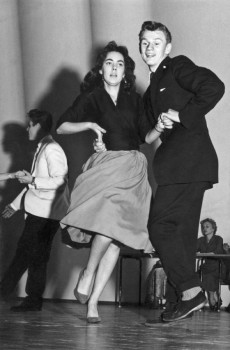
Rock around the clock in Helsinki, too! All photos here from Rasvaletti; photographer unknown, 1958
Rasvaletti. Valokuvia 1950-luvun Helsingistä /
Fotografier från 1950-talets Helsingfors
[Hair-grease. Photographs from 1950s Helsinki]
Työryhmä [working group]: Yki Hytönen, Tuomas Myrén, Riitta Pakarinen, Aki Pohjankyrö, Hilkka Vallisaari
Helsinki: Helsingin kaupunginmuseo, Helsinki City Museum,
2013. 211 pp., ill.
ISBN 978-952-272-499-1
€45, hardback
Onnen aika? Valoja ja varjoja 1950-luvulla
[Time of happiness? Light and shadow in the 1950s]
Toimittaneet [Ed. by]: Kirsi-Maria Hytönen & Keijo Rantanen
Jyväskylä: Atena, 2013. 249 pp., ill.
ISBN 978-951-796-924-6
38€, hardback
The 1950s rocked! They literally did – that is when the world got rhythm: Blue Suede Shoes by Elvis and the film Blackboard Jungle, with Bill Haley’s hit Rock Around the Clock, for example.
The development of new sound reproduction – long-playing records and tape recorders – was essential to the spreading of the gospel of rock and pop here, there and everywhere.
In Finland, the shocking new music was a smash hit among a group of young urban men called lättähatut, flathats, who also wore tight trousers, black overcoats and pointed shoes. Their girls dressed in angora sweaters and tight trousers or skirts. These teenagers, who hung around together very late in the evenings, were largely considered not only a nuisance but also a possible danger to the peaceful development of society (not only in Finland…). More…
National treasures
7 April 2011 | This 'n' that

The name of the game: ice hockey. Photo: Jaakko Oksa
In Japan, artists or craftsmen of the highest quality may be honoured with the title ‘Living National Treasure’. In Finland, it seems only ice hockey players are eligible for that title, if you ask the man on the street, as ice hockey seems to be Finland’s ‘national’ sport.
(For example another ice team sport, synchronised skating, doesn’t compete in the same national treasure series, despite the fact that the Finnish team won the gold – again – in the World Championships in April. [Finland has won gold six times, Sweden five.] No national flag-waving resulted. But of course they are just women, who don’t win sports wars against other nations.)
On Sunday, 15 May, a dream came true at last, as Finland won the gold medal at the Ice Hockey World Tournament. And what’s more, it was Sweden – neighbour and old colonial overlord – they beat (6–1).
As the victorious team, escorted by a Hornet fighter from the Finnish air force, returned from Bratislava to Helsinki on Monday night, some 100,000 people crowded the capital’s Market Square to celebrate. The team and a selection of pop musicians climbed up on a stage to start the party – and President Tarja Halonen also popped in, from her presidential palace by the Square, to congratulate.
When’s the last time when 100,000 Finns gathered anywhere? Perhaps in 1995, when Finland first won the same title? See the series of photographs on the Internet pages of the Swedish paper Aftonbladet, particularly a shot of Helsinki harbour taken with a fish-eye lens.
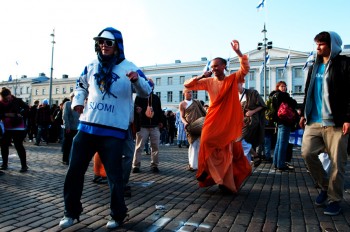
All together now! Photo: Jaakko Oksa
Sweden has been a much more successful hockey country than Finland, but it’s clearly tough to be a good loser. As the rivalry – in sports in particular – between Sweden and Finland is traditionally a larger-than-life issue, the Swedish newspapers and their readers displayed a highly amusing spectrum of opinions. ‘Kul att dom får fira något. Dom bor ju trots allt i Finland’ (‘Great that they have something to celebrate. After all, they live in Finland’), said one reader sourly.
And celebrate they did. One of the coaches stumbled and fell on his face on the red carpet on landing in Helsinki, and before you could say oops, he ended up on the YouTube accompanied by extracts from the final match television coverage by the celebrity sports commentator Antero Mertaranta.
Sportsmen and -women are supposed to be positive role models for young people, but as some of the team members clearly seemed to enjoy something stronger than sports drinks on the Market Square, they have been reproached for this behaviour by many people – spoilsports?
The coach of the Finnish national team, Jukka Jalonen, said in an interview that he could not condemn the use of alcohol in celebrating a ‘rare achievement’ like this, as ‘children and young people surely understand that adults may sometimes get drunk. Many of them have seen their parents sloshed.’
Well, if we assume it’s OK to be drunk in front of your children, it is no wonder that younger and younger children start drinking – which, however, is not considered OK, not by anyone. Can someone explain this?
Night decorator
31 March 2007 | Archives online, Fiction, Prose
A short story from the collection Yönseutuun (‘Around nighttime’, WSOY, 2006). Introduction by Jani Saxell
Hardly a night went by.
I didn’t want to offend him in any way by my indifference, but as I went to bed I was totally beat, squeezed dry by my day. My most important chore at home was to guard my own rest; people’s survival depended on it being consistent and nourishing. I didn’t concentrate on anything else in my free time.
But often when I was ready for bed, a sharp metal ‘zzzip’ would come from the direction of the living room. A little later I would hear a drawn-out ‘clllack!’, which told me the measuring tape had retracted into its case, the newest interior design had taken shape on the back of some receipt, and Y would soon be coming to see if I was awake and open to suggestions. More…
Country matters
30 June 2001 | Archives online, Fiction, Prose
A short story from Peili (‘Mirror’, Tammi, 2000). Introduction by Suvi Ahola
I’m getting so old, my Master and Mistress no longer take note of when I’m on Heat. They don’t even notice when some moisture comes dripping out of my innards, as a sign of it, like they did in the good old days. Anyway, this time I really boobed, I dirtied my Mistress’s Christmas slippers with my secretions. So what could I do? – if it drips it drips. I happened to be lying on my Mistress’s feet at the time, she’d invited me there herself. ‘Spot, Spot, come and warm my feet,’ she said. Of course I went, I always have done when I’m called, it’s rather nice. Your belly gets nice and warm there, and if you’re lucky your Mistress scratches your back now and then with her knitting needle. I sleep and snore a little – it amuses my Mistress and Master. But then the warming of my belly led to this boob – a big dose of this wetness slurped onto my Mistress’s feet. It caused a sudden departure. My Mistress yelled, and my Master flung me out into the yard. I’d scarcely managed a squeak before I found myself in the snow. I shan’t forgive them, no. It’s beyond my comprehension.
Toward good management practice
31 December 2003 | Archives online, Fiction, Prose
A short story from the collection Värjättyä rakkautta (‘Dyed love’, Otava, 2003). Introduction by Harry Forsblom
Because queries from the field have recently been received concerning the allocation of investment resources in our production facility in a business environment that is undergoing pressures for change, we have in close collaboration with other production organisations, drawn up a booklet on good management practice whose intention is in broad outline and by production sector to delineate in what way the current market situation should be taken into account in the practising of our trade.
The booklet Toward good management practice. Functional spatial planning, utility-oriented measures and allocation of production aims, in keeping with its subtitle, to present, by utility sector, the latest research-based knowledge in the field and thus offer our membership aids to decision-making in designing organisational innovations that demand investment. More…
Out of this world
31 December 1996 | Archives online, Fiction, Prose
Extracts from the novel Virkamatka (‘Business travel’, Otava, 1996). Introduction by Jyrki Kiiskinen
I spent a couple of weeks alone at home that summer. My brother was at camp and my father on a business trip. Bored one rainy day, I opened up their last game on the computer. They had been going on about it for weeks.
I began from the beginning, A splendid start: texts backed by imaginative visions, Then darkness. In the middle of it a gold-coloured, glimmering dot. Nothing else. I waited for a long time. Nothing else, I waited. Nothing. Then I pressed the computer’s space-bar. The dot exploded and the explosion filled the entire screen. From its centre swarmed familiar patterns, Diagrams of atomic nuclei, electrons, radiation. More…
To sleep, to die
30 September 2004 | Fiction, Prose
Extracts from the novel Unelmakuolema (‘Dreamdeath’, Teos, 2004)
Dreamdeath
Who would not like to cheat the grim reaper? Ways are known, of course, both scientific and non-scientific, but all of them are uncertain and temporary. Except for the simplest: to get there first oneself.
The refinement of this idea was Dreamdeath’s business idea. ‘Dreamdeath – because you deserve it!’ went Dreamdeath’s slogan.
The Dreamdeath home offered those who wished it the means to the most pleasant, even luxurious realisation of an autonomic death in an atmosphere of moral approval, against a suitable fee. At Dreamdeath the client himself decided when and in what conditions he would leave his mortal clay. More…
Art or politics?
16 February 2012 | This 'n' that
You’re going about your business in Helsinki Railway Station on a cold winter’s day — waiting for your train, buying tickets or newspapers or just taking short-cut through the building to keep warm – when suddenly the bloke next to you bursts into song. And not just him: along with a couple of dozen others, he makes the air ring with the patriotic song Finlandia, sung in harmony and perfectly in tune. (The video can be viewed at http://www.youtube.com/watch?v=wO63xt2jWtc) More…
Perfect thing
31 December 2000 | Archives online, Fiction, Prose
Extracts from the novel Ennen päivänlaskua ei voi (‘Not before sundown’, Tammi, 2000). Interview and introduction by Soila Lehtonen
A youngster is asleep on the asphalt in the backyard, near the dustbins. In the dark I can only make out a black shape among the shadows.
I creep closer and reach out my hand. The figure clearly hears me coming, weakly raises its head from the crouching position for a moment, opens its eyes, and I can finally make out what it is.
It’s the most beautiful thing I’ve ever seen.
I know straight away that I want it. More…
Funny stuff
1 April 2009 | In the news
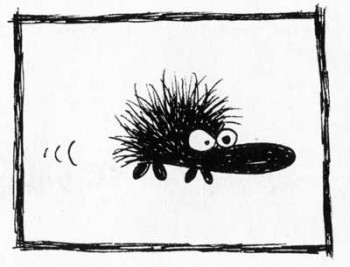
Milla Paloniemi's swearing hedgehog
For the first time, comic books rule the latest bestsellers list of Finnish fiction.
A cartoon series called Fingerpori by Pertti Jarla evidently tickles the Finnish funny bone, as three of his collections occupy the second, sixth and eighth places on the February top ten list, compiled by the Booksellers’ Association of Finland. More…
Northern exposure
21 June 2012 | Reviews
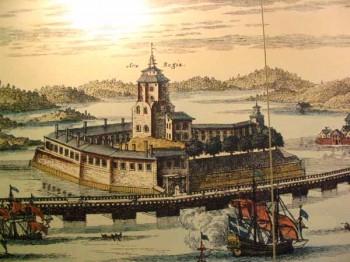
Between Helsinki and St Petersburg: Vyborg. Illustration of Vyborg Castle by an unknown artist, 1709, Wikimedia
Tony Lurcock
‘Not So Barren or Uncultivated’. British travellers in Finland 1760–1830
London: CB Editions, 2010. 230 p.
ISBN 9-780956-107398
£10.00, paperback
Finland is not unique in raising scholars who have often attempted to treat historical travellers’ accounts as source material for historical facts, and then prove how ‘wrong’ they are in relation to reality. This is an unproductive way in which to read them: travel books are nearly always based on the authors’ own country and experiences projected on what they encounter abroad.
Paradoxically, much of what was written about foreign countries in the past was really about conditions and problems in the author’s own land, and can be understood only against that background – something that also emerges in this book about British travellers in Finland. More…
Writers meet again in Lahti
14 May 2009 | In the news
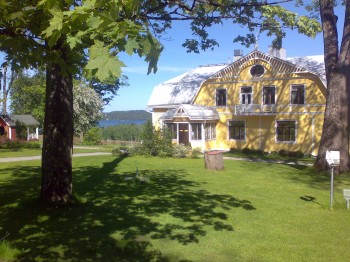
In other words: LIWRE at Messilä Manor
The Lahti International Writers’ Reunion (LIWRE; www.liwre.fi) will be held this year between 14 and 16 June.
In the politically and culturally active 1960s, marked by the confrontation between East and West, an idea was born to found an international, bi-annual rendezvous where writers from all over the world could freely engage in discussions on various themes.


